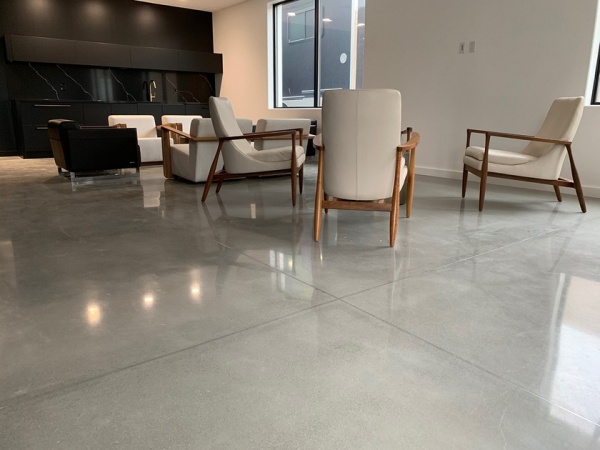Concrete Polishing
Jump to navigation
Jump to search
![]() Hint: Polished concrete is considered a green material by LEED. Polishing provides beautiful finish to standard concrete. It is primarily labor - not exotic materials. 3000 grit is highly polished - [1]
Hint: Polished concrete is considered a green material by LEED. Polishing provides beautiful finish to standard concrete. It is primarily labor - not exotic materials. 3000 grit is highly polished - [1]
Wet or Dry
- Dry advantage - no cleanup and shinier. [2]
About and Materials
- 9 Days to polish -
- Polished vs epoxy -
Sourcing
- Orbital sander pads - [5]
- Use 6 of these at one time mounted to a common bar, if you have open space to work with. Each is under 4 lb, so 24 lb total + mounting bar. 3A each for a total of 18A
- Start with bulk grinding of rough spots - [9] - using a regular grinder:
- Start with 50 grit dry - $10 for one - [10]
Diamond Cups
How to Use an Orbital Sander
- 15 seconds per foot travel rate:
Lessons:
- collect dust, so you don't get larger abrasive spots from dust clumps
- Go slow - pigtails will shrink
- Calculations - if 15 seconds per foot, we have 39 passes lengthwise for one passthrough - meaning 1248 feet - meaning 5.2 hours per 500 sf pad. Save 20% by not doing under stairs and cabinets, you have 4.7 hours per pass. 5 sander gang gets that down to 1 hour. Definitely could use a holder for 6-10 sanders. If they can be ganged - that would be awesome.
- Don't skimp on the grits - go up more slowly, which is actually faster.
- Get the dust out - it clogs the sandpaper, and dulls it faster as you need to do more work
- Get extra velcro pads
- Store sander with pad on, so you don't flatten velcro hooks.
Other Options
- Good thread - [15]
- Car polisher will work, and so will a variable speed grinder with diamond pads.
- Get this grinder with variable speed can be found elsewhere cheaper. [16]. Pads - [17]. Pad holder - http://www.toolocity.com/4-back-holder-rigid.aspx
- HF variable speed polisher 1 - $44 - 10A - [18]
- High speed concrete/steel abrasive pads - 4" - only $6 for 5 - [19]
- 7" diamond pads are much more expensive - 800 grit for one - $30 - [20]
Concrete Countertop Details
- Includes filling voids with concrete fortifier + concrete, then sealer, then wax, and silicone between slabs to fill in cracks. [25]
Going Pro
- 22", 12 pad sander - 500-1000 sf/hr rate - [26]. If there are 8 grind steps - that is a whole day job for 500 sf.
- 15 amp - 11" width. [27]
Densifier and Guard
- Densifier - lithium based - [28]
- Stain guard - waterproof, probably not breathable - applied before last polishing step - [29]
- Lithium vs silicate densifier - [30]. Lithium penetrates deeper.
- Sodium silicate densifier - [31]
- Colloidal silicates appear to be even better? [32]
When to Densify?
- 200-400 grit step most of the time. [33] Otherwise it doesn't penetrate enough? Or prevents you from buffing properly on the higher-shine grit?
- If really soft - densify early - so it could be shined at all. [34]
- How much to add? Until rejection. No controversy on this. Just read the floor. [35]
- Start with 5000 PSI concrete, not 3500 PSI - it will polish better [36]
- For longest lasting floor - use potassium silicate, which penetrates more. [37]. For shiniest use lithium.
- Densifier seals cracks up to 0.7 mm [38]
- Use cementitious filler for cracks [39]
Guard or No Guard?
- Read more - [40]
- For residential - no guard.
- Guard wears out. Shine is harder and lasts longer = lower maintenance cost + better look.
- And in all cases - it's a call to opensource it, as the industry is 'segmented' as the article says.
Wikipedia Howto
- Throughout the process, a densifier is used to harden the concrete surface, which allows the concrete to be polished. A number of densifiers can be used; these consist of lithium, potassium or sodium silicates. In some cases, a grouting chemical is also used to fill in any holes, cracks or imperfections that were exposed from the initial coarse grinding step. The concrete can be also finished with a natural-look impregnating polish guard, which penetrates 2–5mm inside the pores of the concrete to prevent any deep staining from oils and spills. It is also breathable and not a sealer (as a sealer actually totally seals the concrete and does not allow vapor transmission). -[41]
- If you just grind, no polish - you can use sealer - but then it won't be the natural shine that is obtained from going to finer grit.
- Discovered only in the 90s?
- Summary:
- Use densifier - hardens the concrete
- Use grout if holes are revealed. Grout is typically cement+water+sand, or epoxy of acid and oil is expected.
- Use polish guard - to prevent deep staining from spills
Cost
- $3-12/sf [42]
